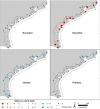The contribution of mangrove expansion to salt marsh loss on the Texas Gulf Coast
- PMID: 25946132
- PMCID: PMC4422646
- DOI: 10.1371/journal.pone.0125404
The contribution of mangrove expansion to salt marsh loss on the Texas Gulf Coast
Abstract
Landscape-level shifts in plant species distribution and abundance can fundamentally change the ecology of an ecosystem. Such shifts are occurring within mangrove-marsh ecotones, where over the last few decades, relatively mild winters have led to mangrove expansion into areas previously occupied by salt marsh plants. On the Texas (USA) coast of the western Gulf of Mexico, most cases of mangrove expansion have been documented within specific bays or watersheds. Based on this body of relatively small-scale work and broader global patterns of mangrove expansion, we hypothesized that there has been a recent regional-level displacement of salt marshes by mangroves. We classified Landsat-5 Thematic Mapper images using artificial neural networks to quantify black mangrove (Avicennia germinans) expansion and salt marsh (Spartina alterniflora and other grass and forb species) loss over 20 years across the entire Texas coast. Between 1990 and 2010, mangrove area grew by 16.1 km(2), a 74% increase. Concurrently, salt marsh area decreased by 77.8 km(2), a 24% net loss. Only 6% of that loss was attributable to mangrove expansion; most salt marsh was lost due to conversion to tidal flats or water, likely a result of relative sea level rise. Our research confirmed that mangroves are expanding and, in some instances, displacing salt marshes at certain locations. However, this shift is not widespread when analyzed at a larger, regional level. Rather, local, relative sea level rise was indirectly implicated as another important driver causing regional-level salt marsh loss. Climate change is expected to accelerate both sea level rise and mangrove expansion; these mechanisms are likely to interact synergistically and contribute to salt marsh loss.
Conflict of interest statement
Figures






References
-
- Archer S, Schimel DS, Holland EA. Mechanisms of shrubland expansion. land use, climate, or CO2? Climatic Change. 1995;29(1).91–9. 10.1007/bf01091640 . - DOI
-
- Fensham RJ, Fairfax RJ, Archer SR. Rainfall, land use and woody vegetation cover change in semi-arid Australian savanna. J Ecol. 2005;93(3).596–606. 10.1111/j.1365-2745.2005.00998.x . - DOI
-
- Doyle TW, Krauss KW, Conner WH, From AS. Predicting the retreat and migration of tidal forests along the northern Gulf of Mexico under sea-level rise. For Ecol Manag. 2010;259(4).770–7. 10.1016/j.foreco.2009.10.023 . - DOI
-
- Asner GP, Elmore AJ, Olander LP, Martin RE, Harris AT. Grazing systems, ecosystem responses, and global change. Annual Review of Environment and Resources. 2004;29261–99. 10.1146/annurev.energy.29.062403.102142 . - DOI
Publication types
MeSH terms
LinkOut - more resources
Full Text Sources
Other Literature Sources
Medical

